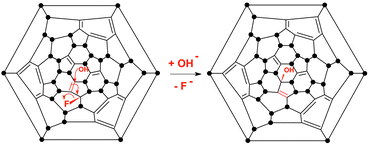On standing in organic solvents containing traces of water, C3 and C1 isomers of C60F36 slowly convert to C1 isomers of C60F35OH. Both fluorofullerenols eliminate HF during EI mass spectrometry to give C60F34O epoxides, one fullerenol being much less stable than the other to the extent that the mass spectrum shows only the epoxide. Both C60F35OH isomers have C1 symmetry, one being identified by the remarkable linear relationship between chemical shifts in its 19F NMR spectrum and those in the spectrum of C1 C60F36; the spectrum of the other shows the pattern of C3 C60F36 rendered asymmetrical by the replacement of one F by OH. The reactions are facilitated by the presence of isolated double bonds, and provide the first proven examples of an SN2′ reaction of a fullerene derivative. Our observation explains why only a limited number of fluorines are readily replaced in C60F36 and why C60F18 is by contrast much more resistant to hydrolysis. We have isolated also a pure isomer of C60F36O, which is shown to be an oxahomofullerene (ether) apparently derived from C1 C60F36, and an impure fraction comprising a fourth isomer of C60F36, a trifluoromethyl derivative of C60F36, a second isomer of C60F36O, and an unknown species of 1392 u.

You have access to this article
 Please wait while we load your content...
Something went wrong. Try again?
Please wait while we load your content...
Something went wrong. Try again?


 Please wait while we load your content...
Please wait while we load your content...